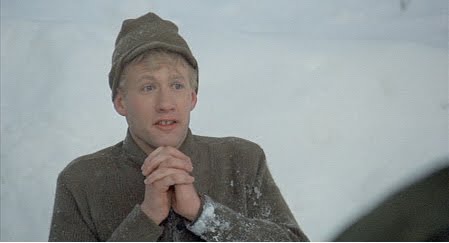“Slaughterhouse-Five” (1972) – 3/5 Stars
Kurt Vonnegut Jr’s book “Slaughterhouse-Five” is a classic and the film version gets by on this fact alone. The rather faithful adaptation is enough to satisfy fans of the novel, but not even the great George Roy Hill can manage to turn Stephen Geller’s uninspired script into a more meaningful movie experience.
To its credit, the film does find a handful of moments to illustrate how its main character, Billy Pilgrim (Michael Sacks), is unstuck in time. Vonnegut Jr’s book is all about its fragmented and displaced structure, making the film’s transitions key to visually re-creating “Slaughterhouse-Five.” A number of these transitions work nicely, but mostly they feel like shifts between Billy during the war, Billy and his family life and Billy on the planet Tralfamador. They’re sometimes quick and uncreative and we fail to ever fully enter Billy’s shoes.
It’s a shame, because Billy Pilgrim is an easy character to sympathize with. His horror stories as a prisoner of war in Germany, living through the bombing of Dresden and the unsatisfactory marriage that he’s sort of participating in are emblematic of many average peoples’ lives. Compound that with the idea that he experiences his life out of order, unable to put anything in the past or avoid the future and his existence is something we can’t help but wonder how we would handle — and ultimately be glad we don’t have to.
Part of the problem is that Vonnegut Jr’s beautiful but difficult prose is lost. Say “So it goes” at the end of a sentence and any literature lover will get your reference. The phrase doesn’t so much as earn a cameo to my recollection in the entire film. Rarely does a film beg for a film-making technique like “Slaughterhouse-Five,” but it’s painfully obvious that it needs voice-over narration, or some kind of guiding force to help us through this structurally disjointed journey.
Hill and Geller create some nice moments that weren’t notable or even included in the book, but it’s all throwaway without something to tie it together, something to complicate Vonnegut Jr’s themes and allude to the epiphany about time at the climax. Instead, Pilgrim’s explanation of time in the final ten minutes is the crux of the entire film, the only moment that really exposes the goal of the story’s chronological experiment.
Geller’s adaptation is just not enough. It’s satisfying and faithful, but it doesn’t leave an imprint like the novel does. The screenplay doesn’t match the intensity of the creative energy from Vonnegut Jr’s classic, it merely attempts to mimic it in the most basic way.
3/5 Stars
“Slaughterhouse-Five” (1972)
Directed by: George Roy Hill
Written by: Stephen Geller, Kurt Vonnegut Jr. (novel)
Starring: Michael Sacks, Ron Liebman, Sharon Gans, Valeri Perrine





0 Comments
You can be the first one to leave a comment.